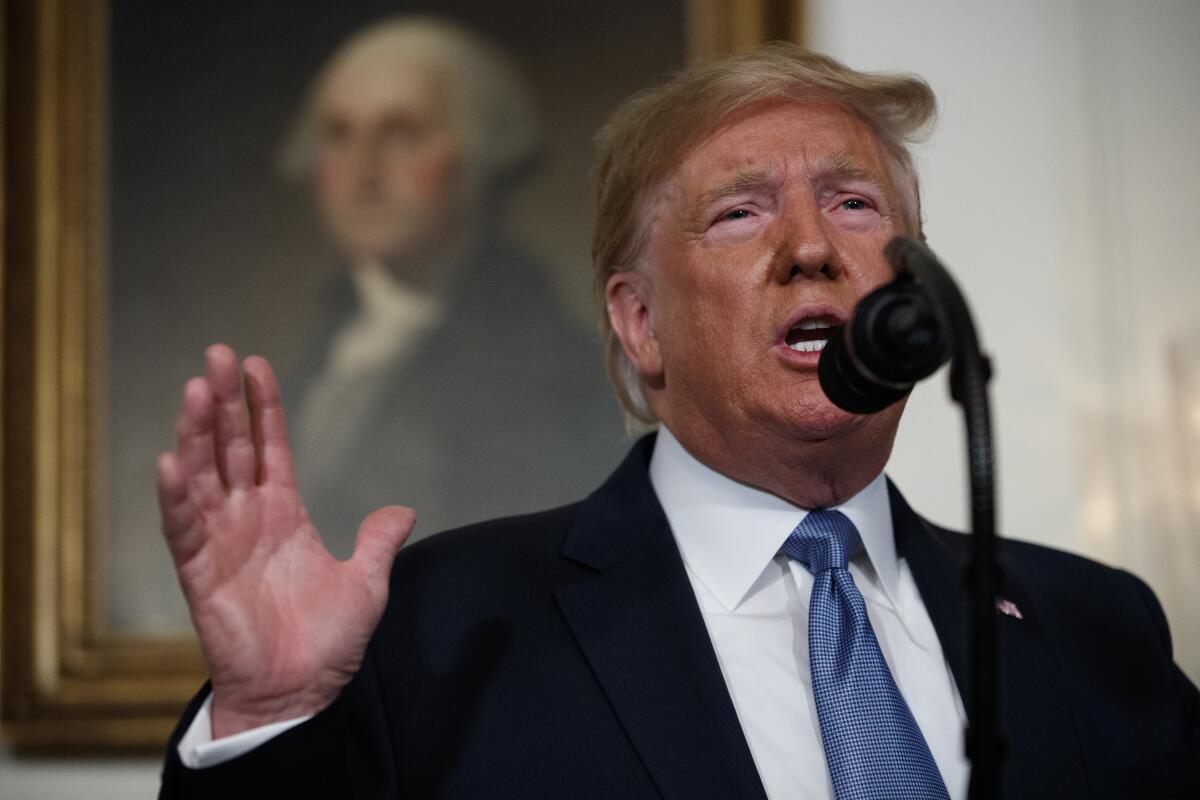Trump backs down again, delays many new tariffs on China until December

- Share via
WASHINGTON — President Trump on Tuesday pulled back from the brink of a dangerous escalation of his trade war with Beijing, putting off until at least mid-December his plan to impose new tariffs on tens of billions of dollars worth of cellphones, laptop computers, toys, shoes and clothes made in China.
Trump said he reconsidered the original Sept. 1 tariff start date because of the potential effect on American consumers during a critical shopping period. “We’re doing this for Christmas season, just in case some of the tariffs would have an impact on U.S. customers,” he told reporters Tuesday.
It also came after financial markets reeled for several days over fears that there was no end in sight for the ongoing trade war and after economists had been sounding alarms, raising their odds that the record-long U.S. economic expansion would grind to a halt next year.
The delay in tariffs, welcomed as it was by U.S. retailers and financial markets, marked the latest maneuver in a now-familiar pattern that has seen Trump turn up the heat on China by threatening tariffs, pulling back as stock indexes falter and then eventually ratcheting up the taxes when talks fail to deliver what he wants.
Trump has already steadily raised tariffs to 25% on about $250 billion of Chinese goods.
Trump’s threat to slap 10% tariffs on the remaining $300 billion of Chinese goods not already being taxed included many household products for which alternative sources are not readily available. That meant American consumers would almost certainly foot some of the higher tariff costs.
The United States trade representative said in a short statement Tuesday that the new 10% tariffs would still take effect as planned on Sept. 1 on some goods from China.
Those include meat products, peanuts, window blinds, bed sheets, trousers, overcoats, keyboards, TV sets, golf shoes and ski boots. The value of all goods facing the higher taxes totaled about $109 billion in the 12 months ending in June, according to an analysis by Panjiva, S&P Global Market Intelligence
The other two-thirds of merchandise not being taxed until December includes cellphones and laptops, which each account for about $40 billion of imports from China. Also on the delayed-tariff list are toys, high chairs, video game consoles, microwave ovens and Christmas tree lights.
“This gives breathing room for the retailers and U.S. companies,” said Doreen Edelman, head of the global trade group at the law firm Lowenstein Sandler. But, she added, 3½ months won’t buy nearly enough time for her business clients to find other suppliers outside of China.
“We’ve got clients that have specialized, high-end sculptures and ornaments being hand-painted from mountain communities in China that have been doing this for years,” she said. “You just can’t pick that up and move that to another country.”
Stocks rebounded Tuesday after days of heavy selling in recent days, with the Dow Jones industrial average up 372.54 points, or 1.44%.
A recession would be a critical blow to Trump’s reelection bid in 2020, as the solidly growing economy is widely seen as his biggest selling point.
Trump’s decision to delay the tariffs was announced by U.S. Trade Representative Robert Lighthizer moments after he talked with China’s lead trade negotiator, Vice Premier Liu He. Lighthizer’s office said another call was planned in two weeks.
But Beijing has not yet confirmed that it will be sending a negotiating team to Washington next month as previously announced by the U.S. side. And the reality is that the two sides must get past critical differences that led to a breakdown in talks in early May, which prompted Trump to threaten the new tariffs.
Trump announced the additional tariffs on Aug. 1 shortly after Lighthizer and Treasury Secretary Steven T. Mnuchin, returned from talks with the Chinese in Shanghai. Sources said Trump, angered by the lack of progress, issued the tariff threat against the advice of top officials. He accused Beijing of failing to make good on its alleged promise to buy a lot of U.S. farm products.
Shortly after the delay announcement Tuesday, Trump renewed his criticisms of Beijing. “As usual, China said they were going to be buying ‘big’ from our great American Farmers. So far they have not done what they said. Maybe this will be different!,” Trump tweeted.
With each new set of U.S. tariffs, Beijing has responded with tit-for-tat measures, leading to hardened attitudes and making it tougher for the two sides to reach an agreement. One of China’s conditions for a deal is that Washington remove the tariffs on Chinese goods.
What’s more, as the trade battle has escalated, additional problems have complicated the relationship, including the U.S. move to block supplies to Chinese telecom firm Huawei and Trump’s official labeling of China as a “currency manipulator” last week.
The increasingly heated protests in Hong Kong against China’s influence over the island is another volatile situation that could be a potential flash point in U.S.-China relations. So far, Trump has said little about it. And on Tuesday, as clashes between protesters and police created chaos at Hong Kong’s airport, Trump told reporters: “The Hong Kong thing is a very tough situation. Very tough. We’ll see what happens. But I’m sure it’ll work out. I hope it works out for everybody, including China, by the way.”
The latest delay in tariffs once again renewed hopes for a resolution to the U.S.-China trade war. But many analysts doubt that the two sides are ready to make compromises that would lead to the kind of comprehensive deal that Trump has said he wants.
Trump has sought massive Chinese purchases of American goods in the hope of narrowing China’s fat trade surplus. Lighthizer has pushed for structural reforms in the way China’s central government runs its economy, including the heavy subsidization of companies and requirements that pressure foreign companies to hand over their technology secrets in order to access China’s large markets.
With the delay in tariffs and some ambiguity in its statement, “the USTR has left itself an enormous amount of wiggle room,” said Craig Allen,president of the U.S.-China Business Council, which represents many large multinational firms doing business in China. “Where do we come out of all this? Final decisions haven’t been made,” he said.
What’s clear, he said, is that tariffs are not the answer. “We have the Chinese’s attention,” Allen said, noting that it would be best for the two sides to negotiate a more narrow deal over, say, intellectual property issues rather than trying to come out with a big, all-encompassing agreement.
“The overall bilateral relationship is bedeviled by so many problems now,” he said. “We must resist the temptation to lump them all together and look for an all-inclusive solution .… We need a small agreement on trade and many other smaller agreements across the range of disputes between the two countries. Let’s get an agreement, stop the downward spiral and keep the world economy on an even keel.”
More to Read
Inside the business of entertainment
The Wide Shot brings you news, analysis and insights on everything from streaming wars to production — and what it all means for the future.
You may occasionally receive promotional content from the Los Angeles Times.











